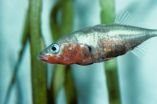(Press-News.org) The great variation of a specific form of immune genes makes organ transplants so complicated. On the other hand, we need such a great variability in order to resist infectious diseases. This is why it also plays a major role in the selection of sexual partners. Up until now, the mechanisms for maintaining this standing genetic variation have remained an evolutionary puzzle. In a study of sticklebacks, researchers from the Max Planck Institute for Evolutionary Biology in Plön, together with colleagues from the Helmholtz Center for Marine Research in Kiel, have now shown that reoccurring infectious diseases determine which individuals produce a particularly large number of offspring in a population, and which immune genes increase in frequency in the next host generation. Infections are thus the drivers for this variability.
We have all read and heard of successful organ transplants. Despite the technical improvement, this clinical achievement is rendered extra complicated by the difficulty in finding a fitting donor to a receiver. This is because the genes at the root of the immune system (called HLA [Human Leucocyte Antigens] in human) are extremely diverse within the population but must not differ between the donor and the receiver for successful transplant. If the HLA differs, the HLA molecules will recognize the new organ as non-self, triggering an immune response against the implanted liver or heart for instance. With more than 1000 HLA immune gene versions (called "alleles") present in the human population any two individuals are likely to differ and thus to be incompatible.
Interestingly, what is a problem for transplanting a liver is an advantage when humans choose their mating partners. As human, we prefer, by smell, those who offer the best complement to our own set of HLA-alleles. This is because we have evolved behaviours to provide our children with the best set of genes to resist infectious diseases. In order to be able to choose the best fitting partner, it is good that there are many possible partners with different mixtures of HLA alleles "on the market". This high variability in individuals' HLA alleles, called polymorphism, is exceptional. In all other genes any two individuals are extremely similar. Which forces maintain this polymorphism that is so badly needed for providing our offspring with optimal mixes of immunogenes but renders transplant so complicated still remains a mystery.
Nicely for scientists, the HLA polymorphism is very similar in other vertebrates where it is called MHC (Major Histocompatibility Complex) polymorphism, including the three-spined stickleback - a small fish found in all lakes and rivers in the northern hemisphere. As is true for the HLA, the primary function of MHC genes is to fight against diseases. It has been suggested that MHC polymorphism is maintained in natural populations by diseases changing from one generation to the next and thus those individuals that happen to have the resistance MHC allele are healthy and thus have more offspring carrying that beneficial allele. To test this idea, scientists from the Max Planck Institute for Evolutionary Biology in Ploen and the Helmholtz Center for Marine Research in Kiel (both in Germany) set up genetically identical experimental populations of three-spined sticklebacks in huge outside mesocosms where each population was exposed to one of two parasite diseases. The fish were allowed to display natural breeding behaviours and females could choose the best partners for reproduction. It is interesting to know that male three-spined stickleback display an intense red coloration on their throat during the mating season- a sign of their health. Changes in MHC allele frequencies were tracked between two generations. Supporting their hypothesis, the scientists found that only those MHC alleles providing resistance to the respective specific parasite disease, that the parental generation had been exposed to, increased in frequency in the next host offspring generation.
The conclusions, exposed in a new article published in Nature Communications this week, are that MHC variation is needed to resist diseases and that the currently adaptive MHC allele spreads in the population so that the next generation is better equipped against this disease – until another disease shows up and other individuals with another MHC allele are healthy and produce more offspring. Now this new adaptive MHC allele will spread. In this way the enormous MHC polymorphism is maintained causing continuous problems with transplantation, but also helping us to produce stronger children every generation.
INFORMATION:
Original paper:
Eizaguirre C., Lenz T. L., Kalbe M., & Milinski M.
Rapid and adaptive evolution of MHC genes under parasite selection in experimental vertebrate populations. Nature Communications. DOI: 10.1038/ncomms1632
Diseases and sex
The cocktail maintaining immune gene variation
2012-01-11
ELSE PRESS RELEASES FROM THIS DATE:
Height loss increases risk for fractures and death in older women
2012-01-11
January 10, 2012 (PORTLAND, Ore.) — Older women who have lost more than two inches in height face an increased risk of breaking bones and dying, according to a new study published in the January issue of the Journal of Bone and Mineral Research and funded by the National Institutes of Health.
The study found that women 65 and older who lost more than two inches over 15 years were 50 percent more likely to both fracture a bone and to die in the subsequent five years, compared to women who lost less than two inches in height.
"Most women do lose height as they age, ...
When galaxy clusters collide
2012-01-11
A UC Davis graduate student who is leading a study of the collision of galaxy clusters 5 billion light years away will discuss the team's findings today, Jan. 10, in a press briefing at the annual meeting of the American Astronomical Society in Austin, Texas.
"A galaxy cluster is like a little universe, because it has the same matter composition as the whole universe," said William Dawson, a Ph.D. candidate in physics. "By studying this little universe, we can learn more about our own."
This "little universe" is formally called DLSCL J0916.2+2951 and consists of two ...
Brain activity linked to delusion-like experience in CAMH study
2012-01-11
For immediate release - January 10 - (Toronto) – In a new study from the Centre for Addiction and Mental Health (CAMH), people with schizophrenia showed greater brain activity during tests that induce a brief, mild form of delusional thinking. This effect wasn't seen in a comparison group without schizophrenia.
The study appears in the December issue of Biological Psychiatry.
"We studied a type of delusion called a delusion of reference, which occurs when people feel that external stimuli such as newspaper articles or strangers' overheard conversations are about them," ...
No pain, no gain? Studies of the ideal way of making jump shots in handball
2012-01-11
Handball is one of the top four sports, at least as far as the risk of injury is concerned. In particular, the jump shot frequently causes sprained ankles, tears to the ligaments connecting the bones of the foot and the lower leg. One of the goals of sports science is to minimize sporting injuries while also improving performance. To this end, many trainers and sports scientists are making increasing use of hi-tech methods, such as the computer modelling of moving joints.
Virtual ankle
To understand why the ankle is so prone to injury during the jump shot, a team ...
Fewer animal experiments thanks to nanosensors
2012-01-11
Countless mice, rats and rabbits die every year in the name of science – and the situation is getting worse. While German laboratories used some 2.41 million animals for scientific research in 2005, by 2009 this number had grown to 2.79 million. One third were destined for fundamental biology research, and the majority were used for researching diseases and developing medical compounds and devices. People demand medicines that are safe and therapies that are tolerable, but hardly anyone is happy to accept the need for animal testing. This is why scientists have spent years ...
70 percent of Europeans suffer from low vitamin D levels
2012-01-11
A group of experts has prepared a report on vitamin D supplementation for menopausal women after it was revealed that Europeans have suffered an alarming decrease in their levels of this vitamin. In their opinion, the ideal would be to maintain blood levels above 30 ng/ml. Vitamin D is essential to the immune system and processes such as calcium absorption.
"We believe that many diseases can be aggravated by a chronic deficiency of vitamin D," states Faustino R. Pérez-López, researcher at the University of Zaragoza. In particular, this is worse during the menopause as ...
Total Mortgage Services Names Neil Bader to Lead Retail Origination Channel
2012-01-11
Total Mortgage Services, LLC, a leading mortgage lender, announced today the hiring of Neil Bader as the Company's National Retail Sales Manager. To this important management position, Mr. Bader brings more than 25 years of production, leadership, and entrepreneurship within the mortgage industry. In his new role, Mr. Bader will be responsible for expanding Total Mortgage's successful retail channel, as it continues its nationwide growth. Mr. Bader will be based in Milford, Connecticut and report directly to John Walsh, President of Total Mortgage.
"Neil is a focused ...
KAIST's smart e-book system more convenient than paper-based books
2012-01-11
Daejeon, Republic of Korea, January 10, 2012—Korea Advanced Institute of Science and Technology (KAIST) announced today that its research team headed by Professor Howon Lee from the IT Convergence Research Institute has developed a technology that will make reading on smartphones and tablet PCs easier than now.
The technology, called the "Smart E-book System," allows users of smartphones and tablet PCs to effortlessly flip through the pages of an e-book or cross-reference its contents, just as they would with paper-based books and magazines.
Unlike conventional displays ...
Increased risk of developing asthma by age of 3 after cesarean
2012-01-11
A new study supports previous findings that children delivered by cesarean section have an increased risk of developing asthma.
The study from the Norwegian Mother and Child Cohort Study (MoBa) suggests that children delivered by cesarean section have an increased risk of asthma at the age of three. This was particularly seen among children without a hereditary tendency to asthma and allergies.
Data from more than 37 000 participants in the MoBa study were used to study the relationship between delivery method and the development of lower respiratory tract infections, ...
Fusion plasma research helps neurologists to hear above the noise
2012-01-11
Fusion plasma researchers at the University of Warwick have teamed up with Cambridge neuroscientists to apply their expertise developed to study inaccessible fusion plasmas in order to significantly improve the understanding of the data obtained from non-invasive study of the fast dynamics of networks in the human brain.
Unless they undertake invasive techniques, neuroscientists are limited to external sensing when studying live brains. One key method the researchers turn to is magnetoencephalography (MEG) in which sensors measure the tiny magnetic fields outside the ...
LAST 30 PRESS RELEASES:
Numbers in our sights affect how we perceive space
SIMJ announces global collaborative book project in commemoration of its 75th anniversary
Air pollution exposure and birth weight
Obstructive sleep apnea risk and mental health conditions among older adults
How talking slows eye movements behind the wheel
The Ceramic Society of Japan’s Oxoate Ceramics Research Association launches new international book project
Heart-brain connection: international study reveals the role of the vagus nerve in keeping the heart young
Researchers identify Rb1 as a predictive biomarker for a new therapeutic strategy in some breast cancers
Survey reveals ethical gaps slowing AI adoption in pediatric surgery
Stimulant ADHD medications work differently than thought
AI overestimates how smart people are, according to HSE economists
HSE researchers create genome-wide map of quadruplexes
Scientists boost cell "powerhouses" to burn more calories
Automatic label checking: The missing step in making reliable medical AI
Low daily alcohol intake linked to 50% heightened mouth cancer risk in India
American Meteorological Society announces Rick Spinrad as 2026 President-Elect
Biomass-based carbon capture spotlighted in newly released global climate webinar recording
Illuminating invisible nano pollutants: advanced bioimaging tracks the full journey of emerging nanoscale contaminants in living systems
How does age affect recovery from spinal cord injury?
Novel AI tool offers prognosis for patients with head and neck cancer
Fathers’ microplastic exposure tied to their children’s metabolic problems
Research validates laboratory model for studying high-grade serous ovarian cancer
SIR 2026 delivers transformative breakthroughs in minimally invasive medicine to improve patient care
Stem Cell Reports most downloaded papers of 2025 highlight the breadth and impact of stem cell research
Oxford-led study estimates NHS spends around 3% of its primary and secondary care budget on the health impacts of heat and cold in England
A researcher’s long quest leads to a smart composite breakthrough
Urban wild bees act as “microbial sensors” of city health.
New study finds where you live affects recovery after a hip fracture
Forecasting the impact of fully automated vehicle adoption on US road traffic injuries
Alcohol-related hospitalizations from 2016 to 2022
[Press-News.org] Diseases and sexThe cocktail maintaining immune gene variation




